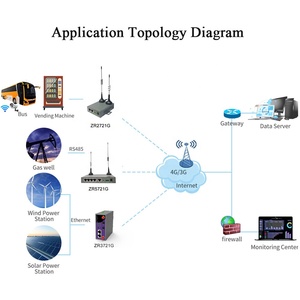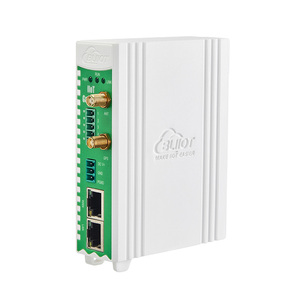(1097 products available)
















































































































































































































An M2M gateway is a critical component that enables communication between devices in an M2M (Machine-to-Machine) or IoT (Internet of Things) environment. M2M refers to the direct communication between machines or devices without human intervention. The M2M Gateway serves as a bridge between M2M devices and the network, facilitating data transmission and providing connectivity solutions.
Types of M2M gateways can be classified depending on protocol, deployment options, and functional capabilities.
Protocol
Different communication protocols are used in M2M applications; M2M gateways help to bridge the gap between them by converting the differences in protocols. This includes MQTT, CoAP, HTTP, and TCP/IP.
Deployment Options
M2M Gateways can be deployed in the cloud or the on-premises. Each deployment type has its own benefits. For instance, cloud-deployed gateways offer a scalable and flexible options for businesses, while on-premises gateways provide more control and may be best for applications requiring low-latency processing.
Functional Capabilities
M2M gateways can be differentiated based on their functional capabilities, which may include protocol conversion, data processing, device management, network connectivity, security, and data management.
Despite the different types of M2M gateways, they have some core features and functions that enable communication between machines and organizations. The following table summarizes the main features and functions of M2M.
Data Transmission
A highlighted function of M2M is sending information from the machine to the M2M gateway for processing. This helps in the working of various applications which include sending alerts, monitoring environmental conditions and energy management among others. Different technologies like GSM, GPRS, GPS, RF, Bluetooth, and satellite are used for data transmission depending on the location, distance, and cost.
Data Processing & Protocol Translation
After the machine or device collects data, it must be processed and sent to a central location for analysis and interpretation. The data received at the M2M gateway is processed then translated and sent to a predetermined destination. Protocol translation ensures seamless communication between devices that use different communication standards.
Security
An M2M communication system connects different devices and applications over a network. It's susceptible to different types of attacks, such as data tampering and eavesdropping. M2M gateways provide messages between endpoint devices. They implement robust security measures to protect sensitive data transmitted between machines.
Application Integration
M2M technology enables developers to integrate various business applications into the system. Examples of applications include messaging, cloud computing, mobile apps, network management tools, and CRM. For instance, Energy companies can integrate their customer relationship management system with M2M gateway devices to monitor assets and respond accordingly.
Device Management
M2M gateway features make it possible to remotely manage, configure, and monitor devices connected to the network. They enable operators to add, update, remove, and activate or deactivate devices on the platform. Device management enhances the user experience by allowing them to troubleshoot issues before they adversely affect their operations.
Every M2M device is unique. That's why effective management depends on custom configuration. Pay-as-you-go M2M platforms are flexible and scalable. They adapt to the specific needs of various users.
Scalability
Businesses and organizations that leverage M2M technology to enhance their operations often start small. They progressively add more devices to their network over time. Thus, they need an M2M gateway that grows with time.Easy addition of devices, maintain consistent performance, and adapt to evolving business goals.
The global market for machine-to-machine (M2M) communication is rapidly expanding, with an estimated 24 billion connected devices by 2030. This trend indicates a growing need for M2M gateways in various sectors, such as industry 4.0, healthcare, smart cities, and the energy sector, among others.
The following applications describe various M2M gateway usage scenarios:
Remote Asset Monitoring and Management
Numerous sectors, including transportation, manufacturing, and utilities, use M2M gateways to keep an eye on remote assets like vehicles, equipment, and machines. The M2M gateway makes it possible to collect and analyze data about the assets' location, state, and performance in real time. Businesses may use this information to optimize asset management, troubleshoot problems, and make educated decisions.
Smart Cities and Urban Development
M2M gateways play a major role in smart city applications. They connect and manage data from various sensors and devices to monitor traffic, control street lighting, detect parking spaces, monitor air quality, and enhance public safety. M2M gateways help city officials optimize resource allocation, develop urban planning strategies, and improve citizen services.
Environmental Monitoring and Conservation
M2M gateways provide connectivity for environmental monitoring applications. They help sensor networks track weather patterns, monitor water quality, detect hazardous materials, and monitor wildlife conservation. M2M gateways enable data collection and analysis for environmental protection, disaster response, and resource conservation purposes.
Healthcare and Telemedicine
M2M gateways are important for remote patient monitoring, home healthcare, and telemedicine applications. They connect medical devices and wearables to healthcare systems to ease chronic disease management, physical activity monitoring, and healthcare delivery. M2M gateways facilitate data exchange between patients, caregivers, and healthcare professionals.
Supply Chain Management and Logistics
Businesses use M2M gateways to improve supply chain and logistics operations. The M2M Gateway makes possible data transfer between IoT devices and applications, thus enabling real-time location tracking of shipments and monitoring the condition of sensitive cargo. This results in an efficient supply chain, increased visibility, and better decision-making.
Industrial Automation and Control
M2M gateways are used to connect to sensors, actuators, and machines in an industrial environment. Their role is to enable data exchange between operational technology (OT) and information technology (IT) systems. M2M gateways facilitate predictive maintenance, production monitoring, remote control of industrial equipment, and optimization of manufacturing processes.
When picking M2M gateways for sale, several pertinent factors should be considered to ensure they will adequately meet the deployment's particular requirements. These include;
The planned application will influence the number of devices to be connected, the type of data, and the communication technology. Hence, evaluating the specific requirements of the M2M or IoT project is crucial, as well as defining the primary application.
Devices connected through an M2M gateway can use wired or wireless communication technologies, so consider the options. Wired technologies include Ethernet, while wireless covers Bluetooth, Wi-Fi, cellular, LPWAN, and satellite technologies like VSAT.
Examine the data the target application will handle, encompassing volume, frequency, and format. Consider the required throughput, low latency, and data transmission capacity to ensure the gateway can manage the data traffic efficiently.
The M2M or IoT deployment may require connecting devices with different wired and wireless interfaces. Hence, choosing a gateway that offers multiple connectivity interfaces to accommodate diverse devices is essential.
In most cases, M2M or IoT applications demand real-time data processing and analysis at the edge of the network, depending on specific latency and bandwidth requirements. This is significant for applications such as telemedicine, remote monitoring, and connected vehicles.
Considering the installation environment is vital to ensure that the selected M2M gateway will function properly under environmental conditions, including humidity, temperature, vibration, and dust levels. These conditions can have a significant impact on an M2M gateway's durability.
Q1: What is the M2M gateway?
A1: The M2M (machine-to-machine) gateway is a safe, dependable route through which many connected devices may exchange accurate, real-time data and information. To facilitate communication between machines, it transforms and transmits data.
Q2: What are the benefits of M2M gateways?
A2: The M2M gateway benefits organizations and industries in various ways, including enhancing operational effectiveness by automating processes, which helps save time and money; enabling data-driven choices by offering real-time analytics and insights; enhancing consumer engagement through personalized services; and enhancing productivity and performance.
Q3: What factors to consider when choosing an M2M Gateway?
A3: There are many important factors to consider when choosing an M2M gateway, such as determining the deployment architecture, which may be on-premises, hybrid, or cloud-based; ensuring scalability and flexibility, which include supporting additional devices and adapting to new use cases; prioritizing security; features and services including but not limited to data management, protocol transformation, and messaging;
Q4: What industries use M2M gateways?
A4: M2M gateways are broadly used across industries to connect machines, devices, and systems to exchange real-time data. These include the manufacturing industry, healthcare, transportation, energy and utilities, retail, smart cities, embedded computing, and telecommunications.